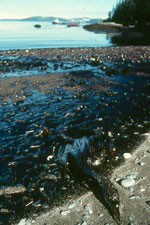
 |
|
 |
|
||||||
|
The
spill had immediate and obvious catastrophic consequences for the ecosystem,
and the people who depended upon the fish and wildlife of the Sound for
their livelihoods and cultures. What was not immediately obvious or anticipated
was the extent of long-term impacts the oil would have on fish, birds
and marine mammal reproduction, the demo-graphic effects of the massive
oil-induced mortalities, and the persistence of oil in the Sound ecosystem.
|
|||||||
|
|
|||||||
|
 |
The
"reopener clause" requires Exxon pay the governments up to an additional
$100 million in the years 2002 - 2006 for natural resource damages that
"could not reasonably have been known nor…anticipated" at the time of
settlement in October, 1991. |
|||||
 |
|
||||||
|
|
|
|
Thirteen
years after the spill, it is clear that many species injured by the
spill have not fully recovered. Resource services listed as having not recovered include subsistence, passive uses, recreation and tourism, and commercial fishing. In fact, some scientists have recently suggested that the Prince William Sound ecosystem may never recover to pre-spill conditions. |